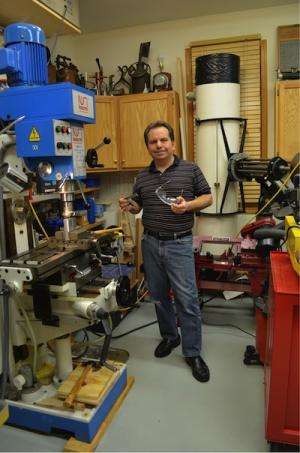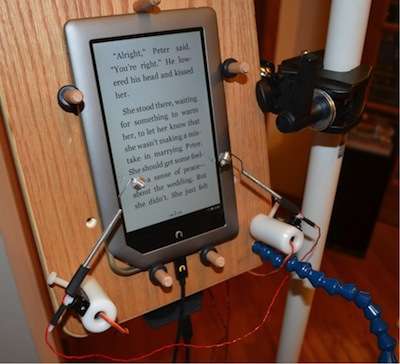Engineer's ingenuity connects MS patient with touchscreen device

For all of its revolutionary promise, the touchscreen technology in smartphones and e-readers is leaving behind people with disabling diseases like multiple sclerosis. Although these patients are often cognitively engaged, they physically can't perform the full range of swipes and taps that unlocks a touchscreen device's potential. And that affects their quality of life.
At the University of Wisconsin-Madison, Christopher Luzzio has combined his skills in machining, neurology and engineering to help Wisconsin MS patient Phyllis Reinen take greater advantage of her e-reader. Luzzio, an associate professor of neurology and mechanical engineering at UW-Madison, constructed an assistive device that allows Reinen to turn the pages on her Nook with very minimal finger movements. Himself a specialist in treating multiple sclerosis, Luzzio initially undertook the project in his spare time, later receiving support from the UW-Madison Center for Rehabilitation Engineering and Assistive Technology (UW-CREATe), an interdisciplinary group that uses engineering and design to help people with disabilities.
"Imagine if you can just move that one finger," Luzzio says. "Anything physically extra that we can allow Phyllis to do is going to make a huge difference."
The device mounts the e-reader on a simple stand and includes a sensor connected to the patient's finger. Using a modular control system, the sensor detects the patient's finger movements, which it then translates those signals to a couple of tiny "arms" that use springs and metal to contact the screen and turn the pages of an e-book. With help from the device, Reinen can now turn e-book pages in either direction and control the speed at which pages turn.

"The UW-CREATe mission is to identify individuals with disabilities for whom we can improve quality of life, with help from engineering students and faculty," Luzzio says. "We use engineering methods to develop solutions that individuals benefit from promptly."
Reinen's husband and primary caretaker, Andy Reinen, says he has built and rigged many devices to help Phyllis in the 13 years since she was diagnosed with MS. "We've even modified an RV, but when it came to electronic things, we were lacking," Andy Reinen says.
Phyllis' doctor referred the Reinens to Luzzio when Phyllis decided she'd like to actually read her books, instead of settling for audio books. "Phyllis is very sharp, and she likes to read as opposed to just listen," Andy says.
Luzzio points out that not just any physical proxy will do for operating a touch-screen device. Many touchscreens respond not to physical pressure, but to the conductive properties of the human finger. "It was challenging to figure out how to get the pages to turn without her actually touching the screen," he says.
In the end, Luzzio bridged the gap by coating the metal arms with ultrasound gel, a substance that's conductive.
The earliest version of the device, which Phyllis began using in September 2013, was fairly low-cost and simple. Luzzio plans to improve it, in part by creating a more comfortable attachment for the patient's finger. In theory, he says, the device could be adjusted to accommodate MS patients who have varying degrees of paralysis. He hopes it ultimately will advance so that it can help those patients enjoy all the functions of touchscreen devices, rather than only turning e-book pages.
Andy Reinen marvels at the fact that Luzzio essentially built the device out of spare parts—for example, a discarded I.V. pole. "He just used cast-off this and cast-off that," Andy says. Yet Luzzio gave the device an appealing touch: It uses an electronic control system, and Luzzio, an accomplished machinist, spent long hours making the parts look professional and attractive.
The important part for now—as Phyllis catches up on favorite authors like Sandra Brown and Nicholas Sparks—is helping people with MS maintain dignity and a sense of purpose. "She's building up stamina to read for longer periods," Andy says. "She can now do something on her own, as opposed to having to rely on somebody else to turn the pages."




















